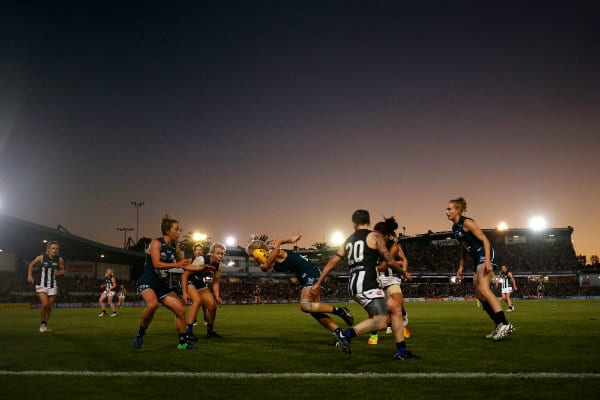Consider the remarks of former Carlton president John Elliot: he described the AFLW grand final and women’s footy as “pathetic”. Consider the reaction to that Tayla Harris photo.
Despite a growing pool of world-class Australian women athletes, a 25-year long study shows that women’s sport is still being undermined by ‘disguised’ sexism.
The study, published in 2017, found that ‘dull, lacklustre coverage makes female sports events seem less exciting than men’s – harming everything from women athletes’ salaries to ticket sales’.
Two years on and while our most popular Australian sports like cricket, AFL and NRL now have female iterations, an increase in prime-time slots and news coverage may not be having a lasting positive impact on the perception of women playing sport.
Our consumption of women’s sport – on TV or in the media – is largely ‘filtered’ through a ‘dismissive male gaze’ that subverts women’s athleticism in favour of their looks or personal lives.
Australian 100m hurdler Michelle Jenneke is more well known for her pre-race warm-up ‘dance’ than her athletic prowess.
US Olympic trap-shooter Corey Cogdell-Unrein has been identified in the media as ‘the wife of a Chicago Bears linebacker’.
US Olympic swimming champion Katie Ledecky recently made headlines for ‘sharing a car ride with Steph Curry’, during which she ‘couldn’t stop smiling’.
Some media outlets defend their lack of women’s sports coverage, arguing that there is poor demand for such news.
Ironically, it’s this kind of opposition to covering women’s sport that may be contributing to its perceived unpopularity, adding weight to the hypothesis that people aren’t interested in women’s sport.
On the Cricket.com.au website, a scroll through their ‘news’ page returns no results for women’s cricket, unless the ‘Australia Women’ filter is selected.
Consequently, it seems our women cricketers enjoy less playing time.
A cursory glance at the fixtures for the Australian women’s team shows there are just seven more matches for the year, compared to 19 for the men’s team.
‘You can’t be what you can’t see’
A 2012 article published on The Conversation by Karen Farquharson, Associate Professor of Sociology at Swinburne University of Technology, found that men’s sport consistently comprises at least 90 percent of sports news.
While the introduction of AFLW and NRL women’s may have led to an overall increase in women’s sport coverage, the rest is still overwhelmingly focused on men’s sport. (Sadly, even horseracing gets more airtime than all of women’s sport.)
One of Farquharson’s lasting observations is the power and influence of men’s sport:
‘The sports considered to be important and well-funded sports are those played by men,’ she wrote.
‘We all know that women play sports, but we often don’t care to know more. Although women’s sport is intrinsically no less entertaining than men’s, few of us attend and the advertisers are far between… The consequence of this lack of attention is that it maintains the subordinate position of women’s sport. Nobody covers it because of the perception that nobody is interested because nobody covers it, and around we go.’
This sentiment is accurately summarised by a 2016 ABC article:
‘There was more coverage of a stomach ache suffered by one male commentator of one male sport than there was for the entire gamut of women’s sports.’
When women’s sport does make mainstream headlines, it’s almost always about off-field issues.
AFLW Carlton player, Taylor Harris, generated an unprecedented amount of media when a photo posted to the 7AFL Twitter account showcasing her athleticism received countless offensive and disturbing comments, prompting its removal.
Although the photo was reposted after public outcry, 7AFL’s response in conceding to online trolls raises concerns over level of sexism ingrained in Australia’s sports culture – and our tendency to avoid addressing it.
The NRL, for example, have been slow to make their women’s league viable or visible, even though women and girl’s participation is the highest growing category in the sport in 2018, up 29 percent from 2017.
Their professional women’s competition is certainly not reflective of women and girl’s rapidly growing interest in the sport.
The entire women’s inaugural season played out over the men’s four-week final series as warmups before the men’s games for ‘maximum exposure’. The grand final was played at ANZ Stadium even prior to the men’s premiership ‘pre-game entertainment’, despite the women’s league being described as having a ‘long, bright future’.
The women’s version of the State of Origin – a three-part series for the men’s NRL competition, played over six weeks – is just one game, played at a venue that hasn’t hosted a men’s first-grade NRL game since 2005.
Sport is a ‘male-controlled institution’
Women’s sport, and particularly women’s iterations of ‘men’s sport’, is subject to intense scrutiny.
Women are critiqued for their performance against a baseline standard set by male athletes, for which women are penalised for overachieving.
Last month, Swiss bike rider Nicole Hanselmann and other women competing in the Omloop Het Nieuwsblad race in Belgium were forced to stop for over five minutes because they had caught up with the men’s race.
Hanselmann had built up a lead of over a minute, and, while she was allowed to keep her head start when the women’s race resumed, the ‘awkward’ stoppage ‘killed’ her momentum, causing her to finish in 74th place.
Hanselmann went faster than the predicted maximum’s women’s speed, just as some men went far slower than their predicted minimum speed.
Why do we punish women athletes for exceeding expectations when we do not penalise men for over or underperforming?
The premise of sport is to challenge physical limitations and overcome adversity even in the face of extreme pressure. But there is an important caveat: with men’s performance as the standard, the women who exceed expectations of their gender are not celebrated as sporting heroes, but instead can be singled out as scientific anomalies.
Just look at the disheartening case of Caster Semenya: the athlete too good, we are told, to be a woman.


